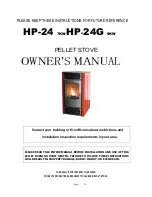
Clearances to furniture and soft furnishings
We recommend that the stove be installed 115 cm from furniture. Serious consideration should also be
given to positioning of any furniture that could be adversely affected by heat. The clearances to
combustible materials in front of the stove should be a minimum of 115 cm. When lit, a wood-burning
stove gets hot and therefore adequate protection must be provided, particularly in situations where
there is a safety risk to children or the infirm. When using this stove in situations where children, aged
and / or infirm persons are present a fireguard manufactured in accordance with BS 8423:2002 must
be used and such persons must be supervised at all times.
It is also recommended that all other people should use a fireguard in accordance with BS 8423:2002
at all times when the stove is alight or hot.
2.4 The chimney.
Refer to current building regulations & any other rule in force, including British standard BS
EN 15287-1:2007 and BS 8303
This product must
never
be connected to any shared chimney.
An efficient modern stove places heavy demands on the chimney, and you should have the chimney
regularly swept and inspected by your approved chimney sweep.
The installer must ensure that the chimney is examined for soundness and suitability before the
appliance is installed. Remedial action should be taken if required, seeking expert advice if necessary.
Where the chimney is believed to have previously served an open fire installation it is possible that the
higher flue gas temperatures from a closed appliance may loosen deposits that were previously firmly
adhered, with the consequent risk of flue blockage. It is therefore recommended that the chimney be
swept a second time within a month of regular use after installation.
The cross-sectional area of the chimney (at its narrowest point) must comply with National and Local
Building Regulations. Generally, the area needed for a wood-burning stove installation should measure
at least
150 mm internal diameter.
An over-sized chimney is generally hard to keep warm and results in poor draft. In cases where there
is an oversized masonry chimney, it is recommended that the chimney be lined using an appropriate
chimney lining system with the correct internal diameter.
With respect to the chimney termination, all chimneys should terminate in accordance with national
and Local Building Regulations.
Note that National and Local Regulations also apply with regard to the placement of chimneys and
flues in connection with thatched roofs.
The chimney or flue system must be equipped with access doors for inspection and cleaning. The size
of the cleaning door in the chimney must at least equal to that of the cross-sectional area of the
chimney. In the event that a chimney fire occurs resulting from faulty operation or prolonged use of
damp wood fuel, close the air vents completely and contact your local fire department immediately.










































